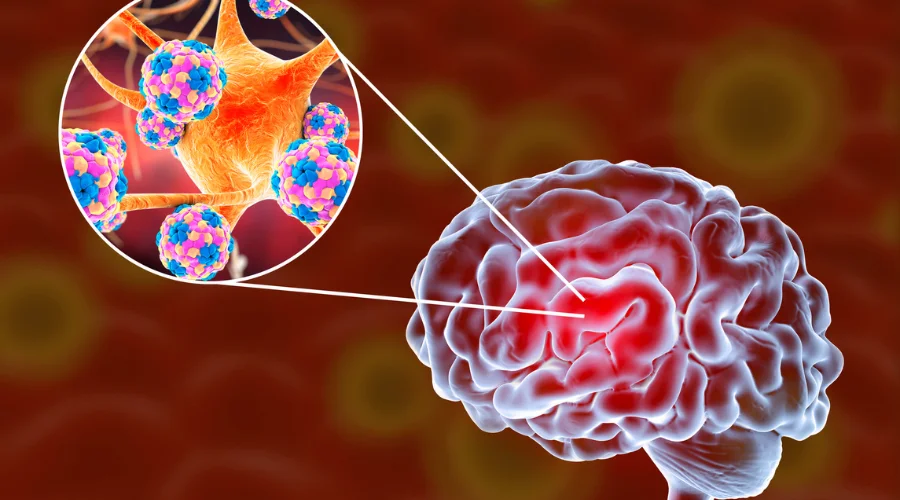Sinusus, the air-filled cavities located within the bones of the skull, are positioned close to the brain.
The frontal sinuses reside above the eyebrows whereas the ethmoid and sphenoid sinuses exist near the skull’s base separated from brain tissue by thin bone walls and membranes.
This anatomical proximity creates a pathway for infections to migrate from the sinuses to the brain through several routes: Infections can advance towards the brain by eroding the bone directly or traveling through blood vessels and natural skull base openings.
A basic sinus infection turns deadly when bacteria spread past protective barriers and invade the brain or its adjacent structures. You should know that when sinus infection spreads to the brain, it becomes a severe complication of sinusitis.
This is when a typical ailment can turn into a critical medical situation. So, recognizing the consequences of infection progression through skull base openings allows timely medical intervention and identification of warning signs, which helps in preventing permanent damage.
What Happens If Sinus Infection Spreads to the Brain? 6 Potential Complications
The spread of a sinus infection across the protective barriers between the sinuses and the brain can lead to multiple severe health complications.
People should urgently consult the best neurologist in Patna when brain involvement symptoms are present because such conditions often require prompt specialized treatment.

1. Brain Abscess Formation
Brain abscess development stands as a grave consequence following the progression of bacterial sinus infection symptoms beyond sinuses. A brain abscess develops when infected matter accumulates within brain tissue, resulting in elevated intracranial pressure.
Severe headaches along with neurological deficits and changes in consciousness represent the symptoms patients often report.
An untreated brain abscess expands quickly which can put pressure on crucial brain structures and result in irreversible brain damage or even death.
2. Meningitis Development
Meningitis develops when an infection penetrates the protective membranes surrounding the brain and spinal cord.
Intense headache and neck stiffness along with high fever and sensitivity to light as well as changes in mental status appear as meningitis symptoms from a sinus infection.
The condition quickly advances which result in brain swelling and seizures along with various neurological issues. Bacterial meningitis poses a severe risk of death and permanent brain damage if treatment is delayed.
3. Epidural Abscess Formation
Epidural Abscess Formation develops when infectious materials accumulate between the skull and the dura mater, which is the outer protective layer of the brain.
The space-occupying lesion elevates intracranial pressure, and, as a result, you may notice intense headaches and focal neurological symptoms with a risk of brain herniation. Emergency surgical treatment becomes necessary to avoid permanent brain injury in this condition.
4. Cavernous Sinus Thrombosis
An infection reaches the cavernous sinus which is a significant vein that lies behind the eyes to develop Cavernous Sinus Thrombosis. Blood clots can block the vessel and can obstruct normal drainage, which leads to dangerous complications.
Under this condition, you may experience intense eye pain alongside vision disturbances, swelling of the eyelids, and numbness in the face.
Without prompt medical attention, this condition becomes life-threatening and could even cause stroke, blindness, or death.
5. Subdural Empyema
Subdural Empyema develops when infectious material collects beneath the brain’s outer covering. The resulting pressure on brain tissue produces seizures and causes body weakness on one side along with changes in consciousness levels.
Without emergency surgical drainage, this condition progresses quickly and leads to permanent neurological damage.
6. Osteomyelitis of Skull Bones
The skull bones become infected in osteomyelitis when bacteria invade the frontal and ethmoid bones. As the infection attacks bone tissue, it generates channels that allow the infection to move towards brain structures.
Affected regions develop swelling while infected patients deal with continuous pain and fever when this infection happens. If you have chronic osteomyelitis, you must undergo extended antibiotic therapy to manage persistent complications.
Signs and Symptoms of Brain Involvement

You need to understand particular warning signs as well as the usual signs of sinus infection to figure out how to tell if sinus infection has spread to the brain and has caused dangerous brain involvement.
Remember that brain involvement in sinus infections leads to neurological symptoms which require urgent medical intervention.
1. Intense Headaches That Surpass Sinus Discomfort
The most frequent early warning sign of brain involvement from sinus infections manifests as severe headaches that stand apart from normal sinus pressure.
Movement and bending forward along with coughing frequently intensify these headaches. Plus, these symptoms are often accompanied by nausea and vomiting.
Patients consistently report experiencing this headache as an extreme pain and the worst headache of their lifetime. These headaches usually surpass sinus-related discomfort.
2. Neurological Symptoms
Neurological manifestations present as confusion along with an altered state of mental function as well as problems with concentration and memory retention.
There can also be some personality changes or unusual behaviour which can lead to reduced responsiveness levels. Seizures present themselves through minor awareness alterations to extreme convulsive episodes.
3. Vision Problems
Vision problems such as double vision together with blurred vision or vision loss reveal significant cranial nerve complications.
The physical manifestations consist of high fever that shows no improvement even with treatment along with neck stiffness and light sensitivity.
Eye area swelling combined with vision difficulties demonstrates potential involvement of brain-adjacent structures. The presence of weakness or numbness on one side of the patient’s body demonstrates brain tissue involvement which necessitates immediate medical assessment.
Recognizing the end stages of a sinus infection enables medical professionals to distinguish between signs of recovery and indicators of serious progression. Recognizing symptoms early leads to better treatment results and lowers the chances of lasting damage.
Diagnostic and Treatment Approaches
Medical professionals deploy extensive diagnostic procedures to detect brain involvement when sinus infections develop into atypical conditions.
CT scans serve as fundamental diagnostic tools by quickly evaluating bone destruction patterns along with fluid collections and brain alterations.
MRI produces high-resolution images of brain tissue and identifies early infection spread that CT scans may overlook.
A lumbar puncture is essential to examine cerebrospinal fluid in meningitis cases but demands cautious assessment because of potential intracranial pressure complications.
Moreover, identifying infection-causing bacteria through blood cultures enables clinicians to choose appropriate antibiotics.
Consulting specialists at advance neuro hospital in Patna grants you access to state-of-the-art diagnostic tools and professional knowledge required for difficult medical cases.
Aggressive antibiotic therapy administered intravenously for multiple weeks is essential for treating brain involvement that originates from sinus infections.
To achieve effective treatment, it is essential to use high-dose antibiotics that have strong penetration capabilities in brain tissue. Surgical treatment becomes essential to drain abscesses while infected tissue is removed and intracranial pressure is relieved.
Supportive care consists of seizure management while also working to reduce brain swelling and monitoring potential complications.
Also, during the critical treatment stages, patients may need intensive care unit monitoring. Immediate medical intervention is required when sinus infection spreads to the brain because treatment delays lead to worse outcomes and higher mortality rates from sinus infections.
Seek Expert Neurological Care at Big Apollo Spectra
Patients need skilled neurologist attention at Big Apollo Spectra for treatment. When sinus infections extend to the brain, they create a critical emergency situation that turns a typical illness into a deadly threat.
The knowledge of anatomical pathways together with the recognition of warning signs and understanding of serious complications highlights why sinus infections that affect the brain need urgent professional evaluation.
When assessing sinus infection recovery, you should monitor typical symptom improvement but any signs indicating brain involvement require urgent medical evaluation.
Although quick solutions to eliminate sinus infections may appear attractive to you, any serious complications require thorough and extended medical treatment beyond just quick fixes.
Early detection combined with a quick medical response serves as the essential strategy for avoiding tragic results.
Doctors should be consulted at once when patients show severe headaches, neurological symptoms, persistent fever, or any worrying changes in mental status.
Through appropriate evaluation and diagnostic testing, healthcare providers can identify the difference between normal sinus infections and dangerous complications.
In instances where individuals display serious sinus infection signs or brain involvement indicators, those who reside in Patna can receive neurological expertise and advanced care options at Big Apollo Spectra. In fact, professional medical evaluation becomes crucial when sinus infections demonstrate serious progression.





